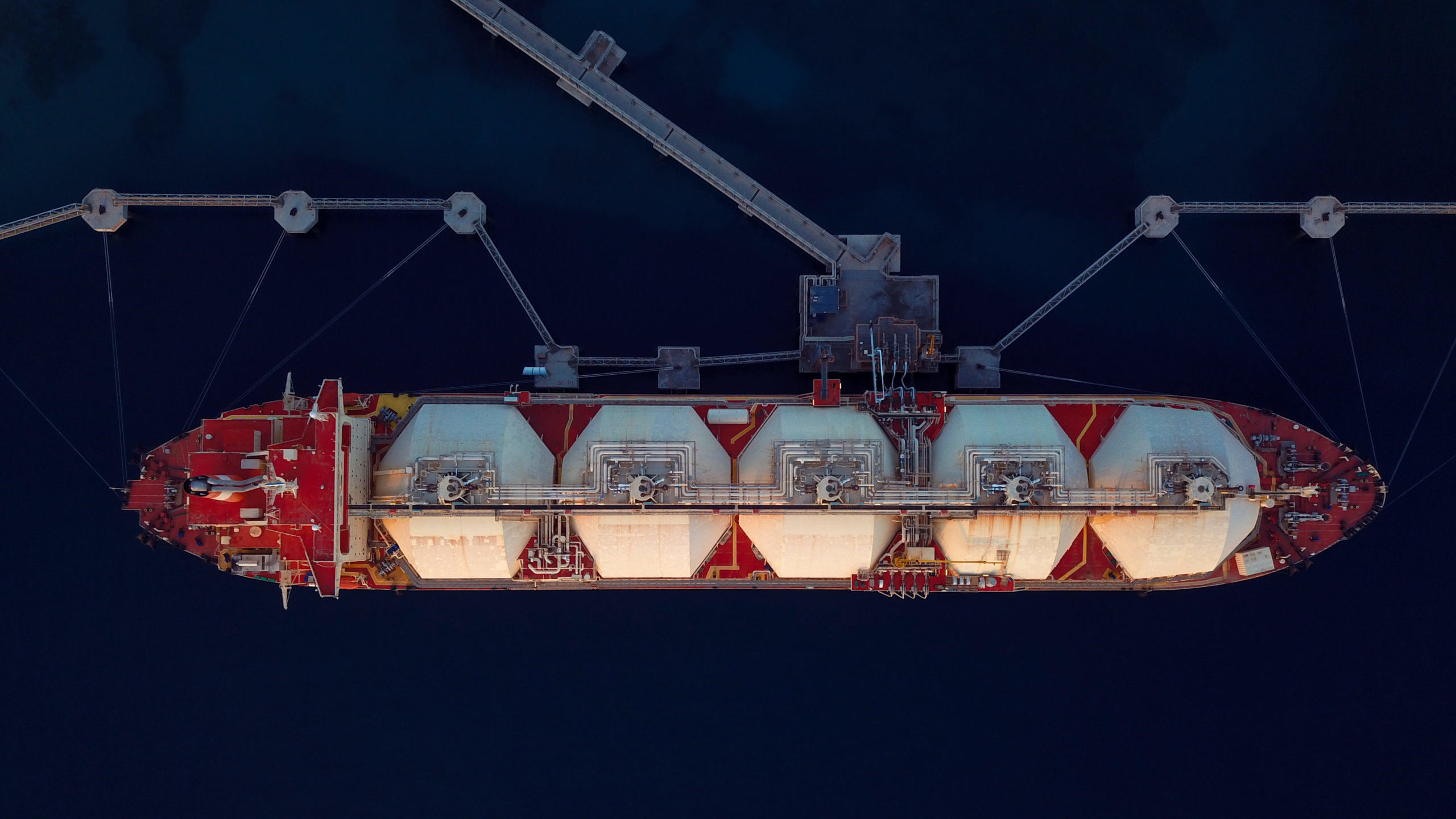To sign up to receive the latest Canadian Energy Centre research to your inbox email: research@canadianenergycentre.ca
Download the PDF here
Download the charts here
Executive Summary
Energy affordability and security are significant global challenges. Liquefied natural gas (LNG)¹ can play a crucial role in helping the world achieve energy affordability and security.
LNG is an increasingly important component of the international natural gas trade, with global trade in LNG reaching US$157 billion annually as of 2021. The global share of LNG as a proportion of all natural gas imports increased from 19 per cent in 1995 to 40 per cent in 2020. Worldwide imports of natural gas in the form of LNG have risen from 97.9 billion cubic meters (bcm) in 1995 to 484.4 bcm in 2020, an increase of 386.4 bcm, or 394 per cent. As of 2021, 21 countries are exporting LNG.
While Canada remains on the sidelines, other nations have attracted LNG investment and benefitted from the rise in LNG export markets. Qatar is building three new LNG projects; Russia is building four new LNG projects, and five new projects are under construction in the United States. Australia, Qatar and the U.S. are the world’s top exporters of LNG.
There is a growing demand for natural gas generally, and LNG specifically, from emerging economies in the AsiaPacific region that are looking to power their economic growth, and from European countries intent on securing their energy supply.
Canada is the world’s fifth-largest producer of natural gas and the largest exporter that is not exporting to either Asia or Europe. For Canada to directly export natural gas to Asia and Europe, it will not only need to increase the volume of natural gas it produces, but will need facilities on its west and east coast that can liquefy the natural gas in preparation for export. If Canada moves forward with its planned LNG facilities, Canadian LNG production would begin in 2025 at 3.3 bcm per year, rising to 55.1 bcm per year by 2039, before falling slightly to 52.6 bcm by 2050.
Global LNG demand is forecast to double and exceed 700 million tonnes (MT) by 2040 from its 2021 level of 380 MT. There is a sizeable gap between the demand for LNG by Asia and Europe and their domestic natural gas production. This gap will be filled by imports from various countries. Canadian LNG can play a significant role in meeting the world’s energy needs if this country can become a reliable supplier.
Introduction
Energy affordability and security are significant global challenges. Liquefied natural gas (LNG)1 can play a crucial role in in helping the world achieve energy affordability and security. LNG is an increasingly important component of the international natural gas trade; in 2021, the value of the global trade in LNG reached US$157 billion annually. The global share of LNG as a proportion of all natural gas imports increased from 19 per cent in 1995 to 40 per cent in 2020. In Asia, 40 per cent of the natural gas imported is in LNG form.
However, despite its abundance of natural gas, Canada exports no LNG. It has only one export terminal (LNG Canada) under construction in British Columbia.² At least four additional facilities are proposed for British Columbia, including Woodfibre LNG, Tilbury LNG, Cedar LNG, and Ksi Lisims LNG. While Canada has remained on the sidelines, other nations have attracted LNG investment and benefited from the rise in LNG export markets. Qatar is building three new LNG projects; Russia is building four new LNG projects, and five new projects are under construction in the United States (IGU, 2021).
There has been significant discussion among policymakers and others as to why LNG projects have not proceeded in Canada beyond the planning stage, except for the one LNG Canada project now under construction in British Columbia (McConaghy and Wallace, 2019; Grant and Grant, 2019).
This CEC Research Brief aims to focus not on that debate, but to review the growth in the global LNG market and the opportunities and challenges Canada faces if it is to be part of the lucrative global LNG trade.
1. LNG is natural gas that has been converted to a liquefied state by cryogenic processing. The LNG supply chain includes production, liquefication, shipping, regasification (converting the liquefied gas back to its gaseous form), and delivery to the end user. Natural gas exporting countries increasingly use LNG to package their natural gas exports where the importing countries have no feasible pipeline access. 2. Canada has one operating LNG import facility, the Canaport terminal in Saint John, New Brunswick.
Growth in the international LNG trade since 1990
Canada has abundant natural gas resources and is a net exporter of natural gas, with all of its exports going to the United States. Still, growing shale gas production in the U.S. has reduced that country’s demand for Canadian gas (Moore et al., 2014).
Consequently, natural gas producers in Canada, as well as those in the U.S., have sought overseas markets for their natural gas exports, including Asian markets where gas transportation through pipelines is not feasible (Moore et al., 2014). U.S. natural gas producers have increased LNG exports in recent years. In 2022, the U.S. became the world’s largest exporter of LNG, overtaking Australia and Qatar. Canadian natural gas producers have been limited— for various reasons—to one export market, the United States.
Many countries are active players in global LNG markets; they are currently operating export terminals and constructing additional facilities. In Canada, at one time, 18 LNG projects had been proposed (Natural Resources Canada, 2020). However, only one is currently under construction due to delays caused by the regulatory regime, financial barriers, or opposition to the projects, including from anti-oil and gas activists (McConaghy and Wallace, 2019).
According to the International Energy Agency (IEA, 2020a), the 2020 decline in natural gas demand will reverse in 2021 and return to its higher pre-Covid-19 levels, with consumption rising even higher in the coming years. Of note, the Asia-Pacific region will account for half of the growth in global natural gas consumption. Global natural gas consumption showed a strong recovery in 2021, with an estimated increase of over four per cent in 2021 over 2020.
The world’s changing energy supply: The proportion of each type of energy
Between 1990 and 2020, global primary energy consumption increased from 342 exajoules (EJ) to 556 EJ. In the same period, the natural gas market share grew from 21 per cent in 1980 to 25 per cent in 2020 (see Figure 1A). In Europe, primary energy consumption accounts for 33 per cent of the natural gas it uses, while in Asia, primary consumption accounts for 12 per cent of natural gas usage. Asia is more reliant on coal for its energy needs and less reliant on natural gas than other regions (see Figure 1B) (B.P. Statistical Review of World Energy database, 2022).

Source: B.P. Statistical Review of World Energy database.
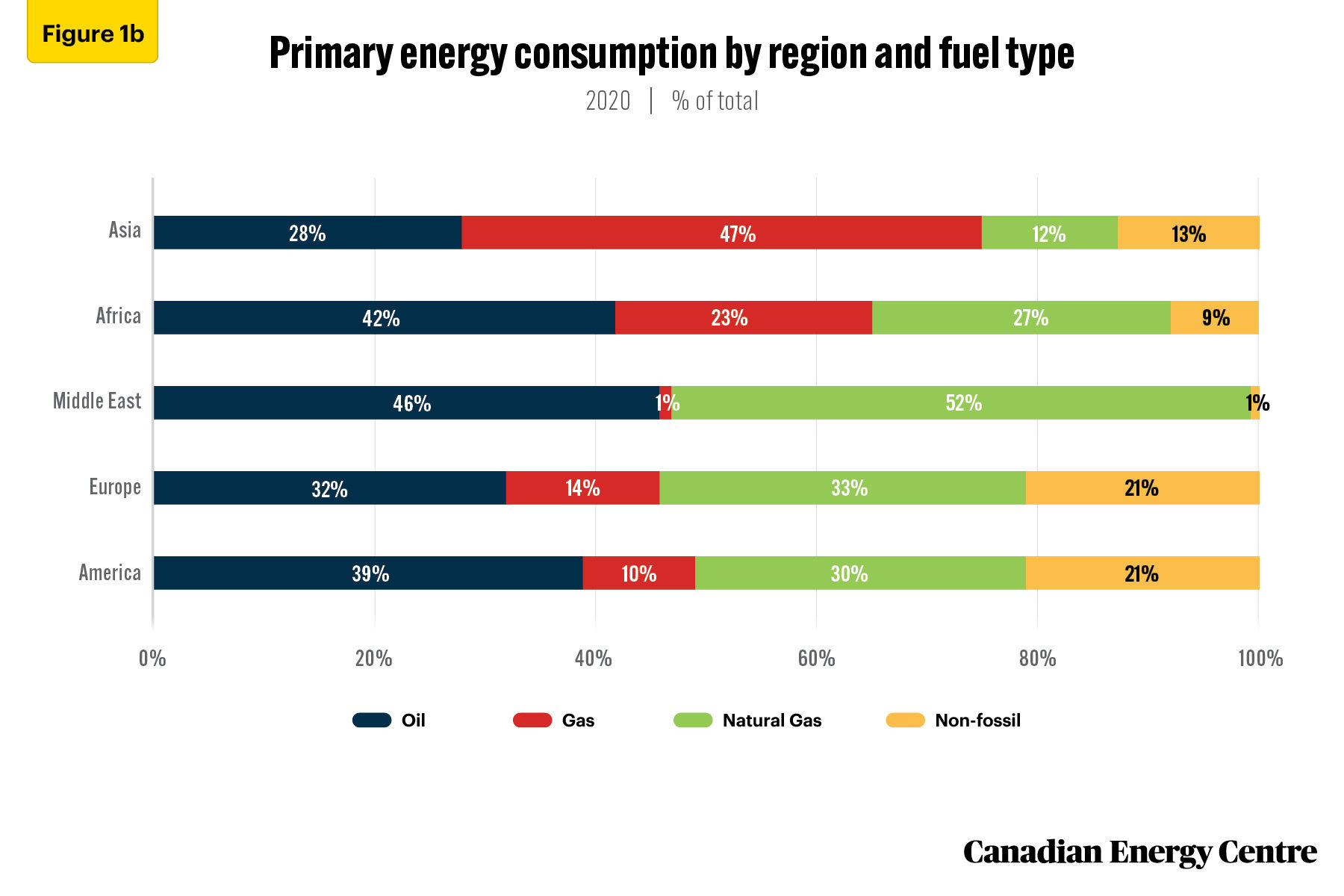
Source: B.P. Statistical Review of World Energy database.
International LNG imports
The growth in the consumption of natural gas has led to increased international natural gas imports both through pipelines and, where pipelines are not feasible, LNG. The international imports of LNG have risen from 75,968 in 1990 to 460,547 Mm3 in 2020 (see Figure 2) (Enerdata, 2022).

Source: Enerdata (2022).
Worldwide international imports of natural gas: Pipeline shipments
Worldwide imports of natural gas through pipelines rose from 398,059 Mm3 in 1995 to 720,718 Mm3 in 2020, increasing 322,659 Mm3 or 81 per cent. The breakdown by region is as follows (see Figure 3a):
• Europe: 395,048 Mm3 in 2020, 37 per cent higher than in 1995; and
• Asia: 148,030 Mm3 in 2020, 553 per cent higher than in 1995 (Enerdata, 2022).
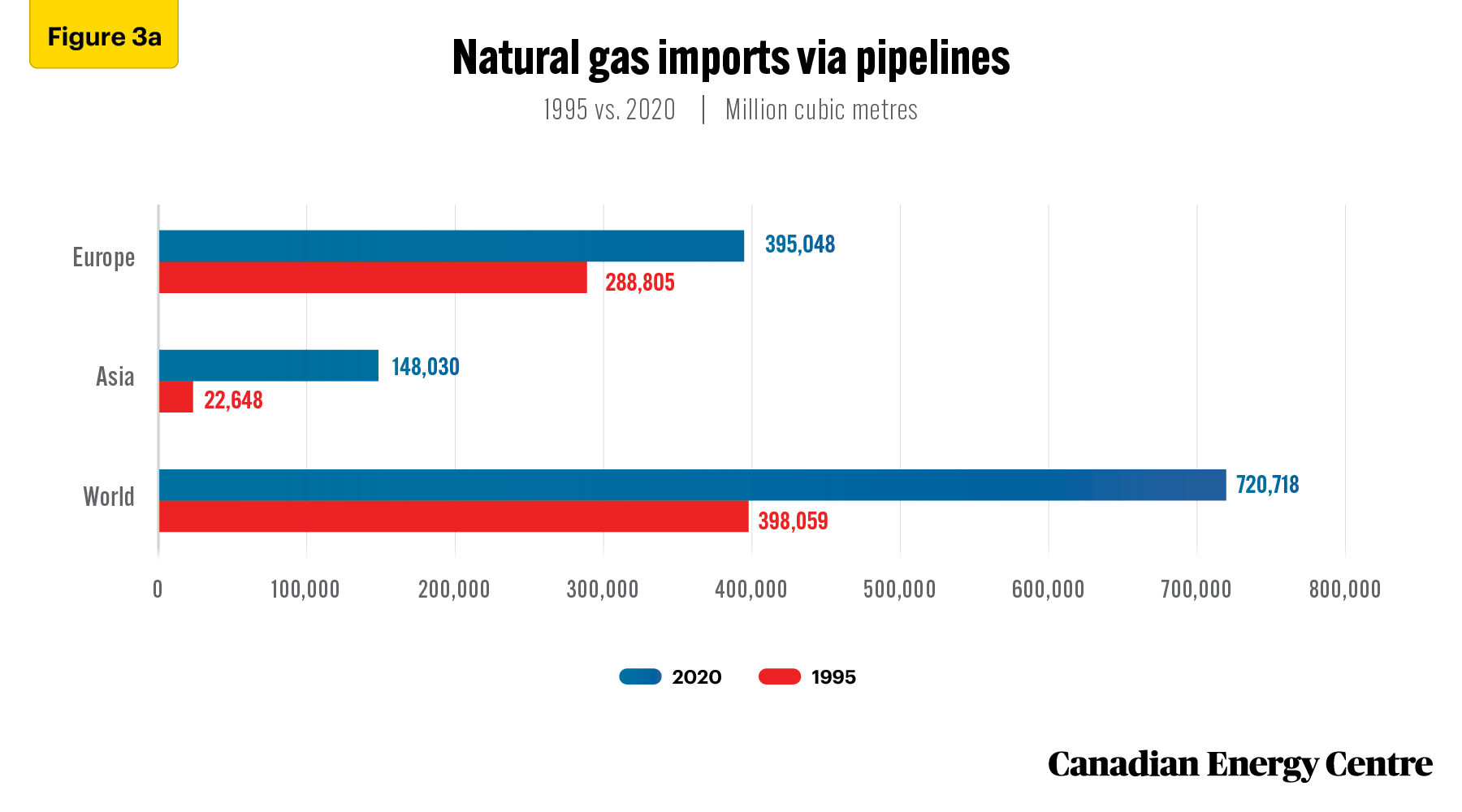
Source: Enerdata (2022).
Worldwide international imports of natural gas: LNG shipments
Worldwide imports of natural gas via LNG rose from 97,923 Mm3 in 1995 to 460,547 Mm3 in 2020, an increase of 362,624 Mm3, or 370 per cent. The breakdown by region is as follows (see Figure 3b):
• Europe: 97,871 Mm3 in 2020, 414 per cent higher than in 1995; and
• Asia: 365,352 Mm3 in 2020, 365 per cent higher than in 1995. The sharpest rise in LNG imports by volume occurred in Asia (up 286,942 Mm3) (Enerdata, 2022).
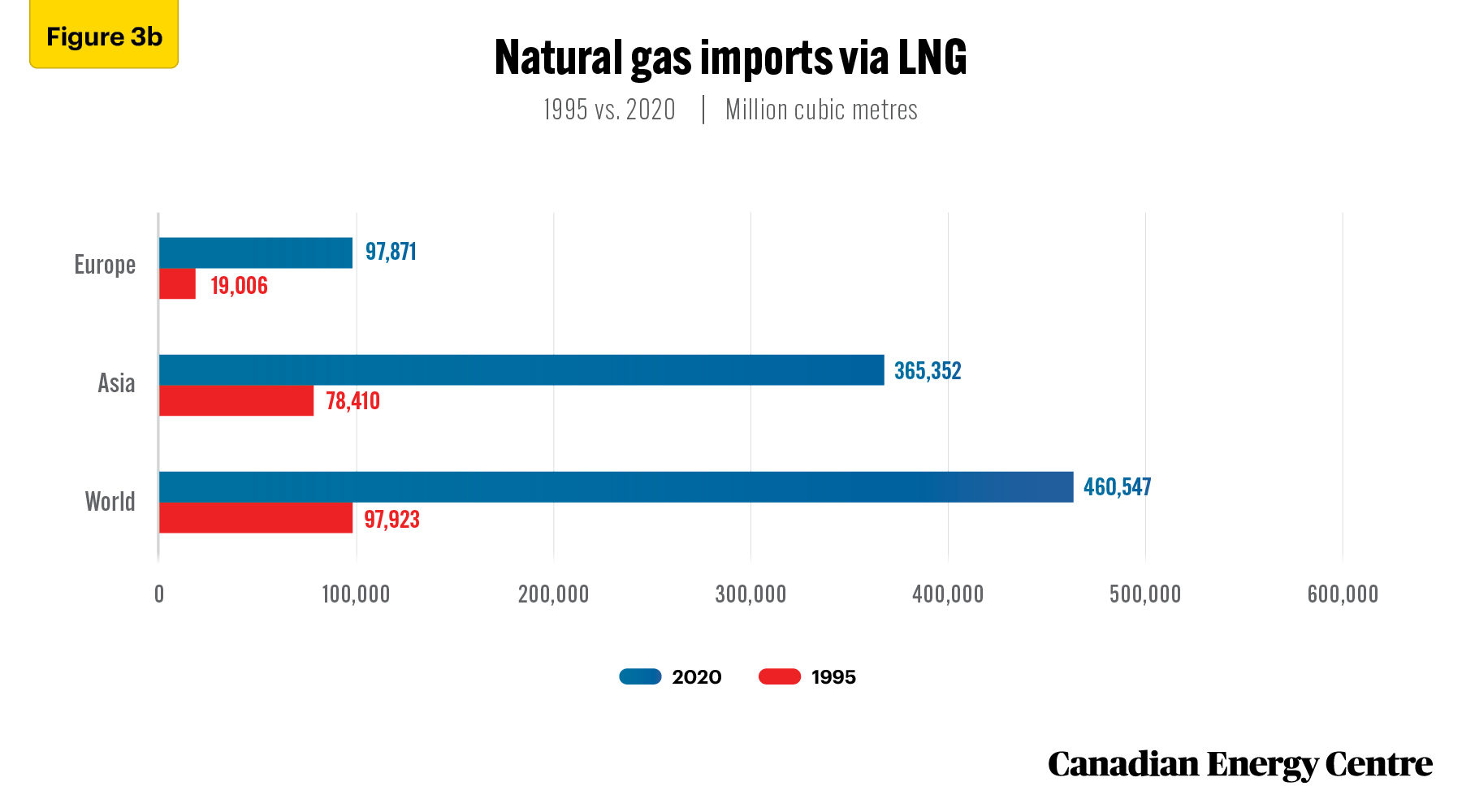
Source: Enerdata (2022).
Major LNG exporting countries
Australia, Qatar, and the United States (U.S.) are the world’s top exporters of LNG. In 2020, Australia exported 108,047 Mm3 of LNG (see Figure 4a) and accounted for 22.6 per cent of global LNG exports. It was followed by Qatar (22 per cent) and the U.S. (12 per cent) (see Figure 4b) (B.P. Statistical Review of World Energy database, 2022).
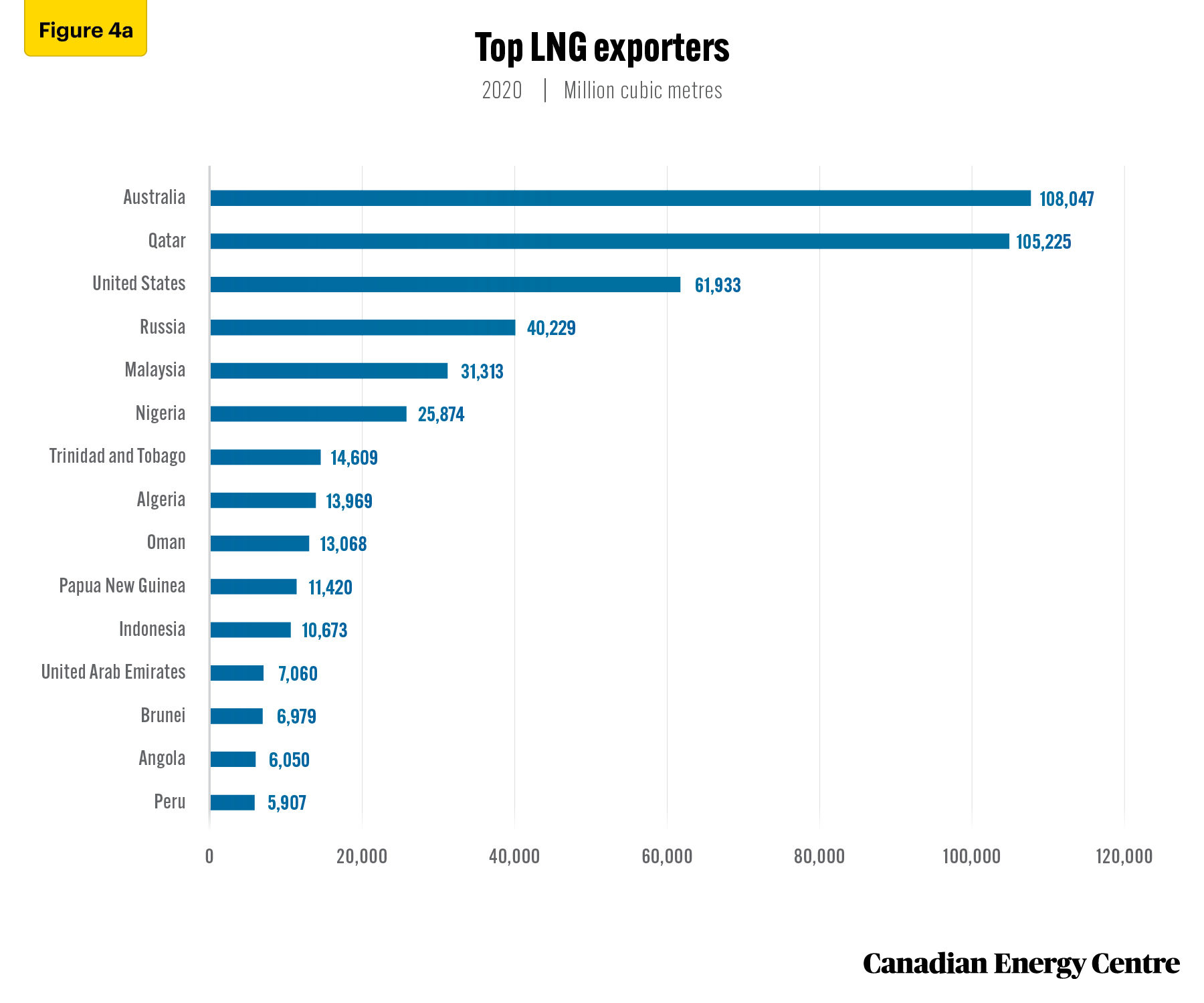
Source: B.P. Statistical Review of World Energy database.

Source: B.P. Statistical Review of World Energy database.
Trends in LNG exports from 1990 to 2020
Several countries, including those listed below, have seen their LNG exports grow significantly between 1990 and 2020 (see Figure 5). They are, in order of the size of the LNG export increase by Mm3:
• Australia: 2,791 Mm3, in 1990 to more than 108,047 Mm3 in 2020, or 3,777 per cent higher;
• Qatar: 2,604 Mm3 in 1997 to 105,225 mm3 in 2020, or 3,940 per cent higher;
• United States: 1,351 Mm3 in 1990 to 61,933 Mm3 in 2020, or 4,484 per cent higher;
• Malaysia: 10,295 Mm3 in 1990 to 31,313 Mm3 in 2020, or 204 per cent higher; and
• Russia: 7,383 Mm3 in 2009 to 40,229 Mm3 in 2020, or 444 per cent higher (Enerdata, 2022).
Despite the global rise of LNG exports and the significant increases in LNG exports from the countries noted above, Canada has yet to participate in the LNG export market.

Source: Enerdata (2022).
The worldwide value of LNG exports from 2010 to 2021
Over the past decade, the global LNG trade has increased by 147 per cent. In 2010, total LNG exports were worth just over US$63.6 billion, a figure that increased to almost US$ 117.4 billion by 2017, before declining to about US$75.9 billion due to COVID-19 and then again increasing to US$157.1 billion in 2021 (see Figure 6) (International Trade Centre, undated).
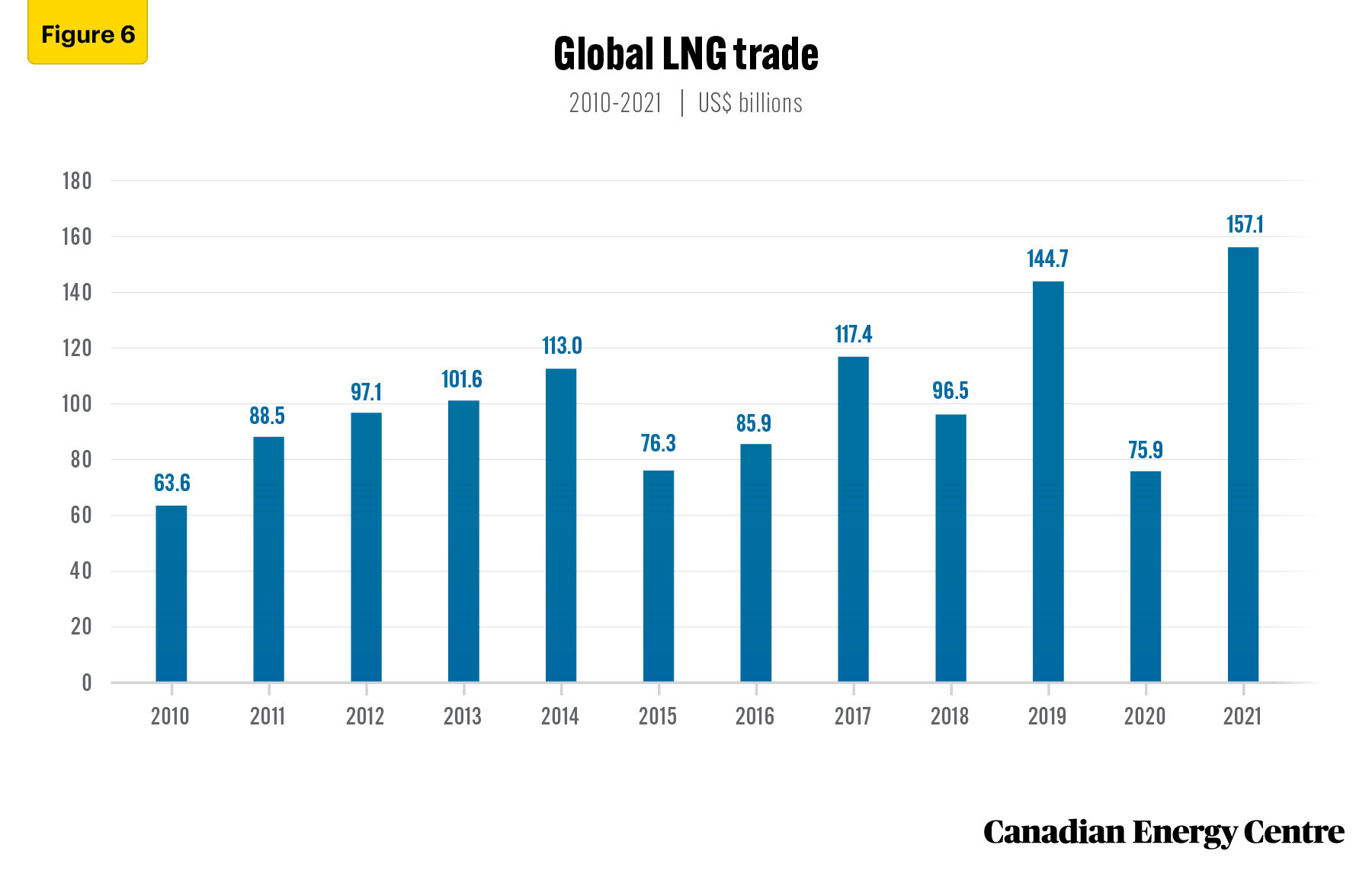
Source: International Trade Centre (undated).
Leading LNG exporters from 2010 to 2021
Between 2010 and 2021, Australia, Qatar, and the United States were the largest exporters of LNG. In 2021 alone, Australia’s LNG exports totalled US$37 billion, an increase of US$28.3 billion from its US$8.7 billion total in LNG exports in 2010. Data are available only intermittently for Qatar, but in 2017 alone, the country exported over $40 billion in LNG. U.S. LNG exports increased from US$600 million in 2010 to nearly $27 billion in 2021. Even new entrant Angola increased its LNG exports from US$200 million in 2015 to US$3.1 billion in 2021 (see Table 1) (International Trade Centre, undated).
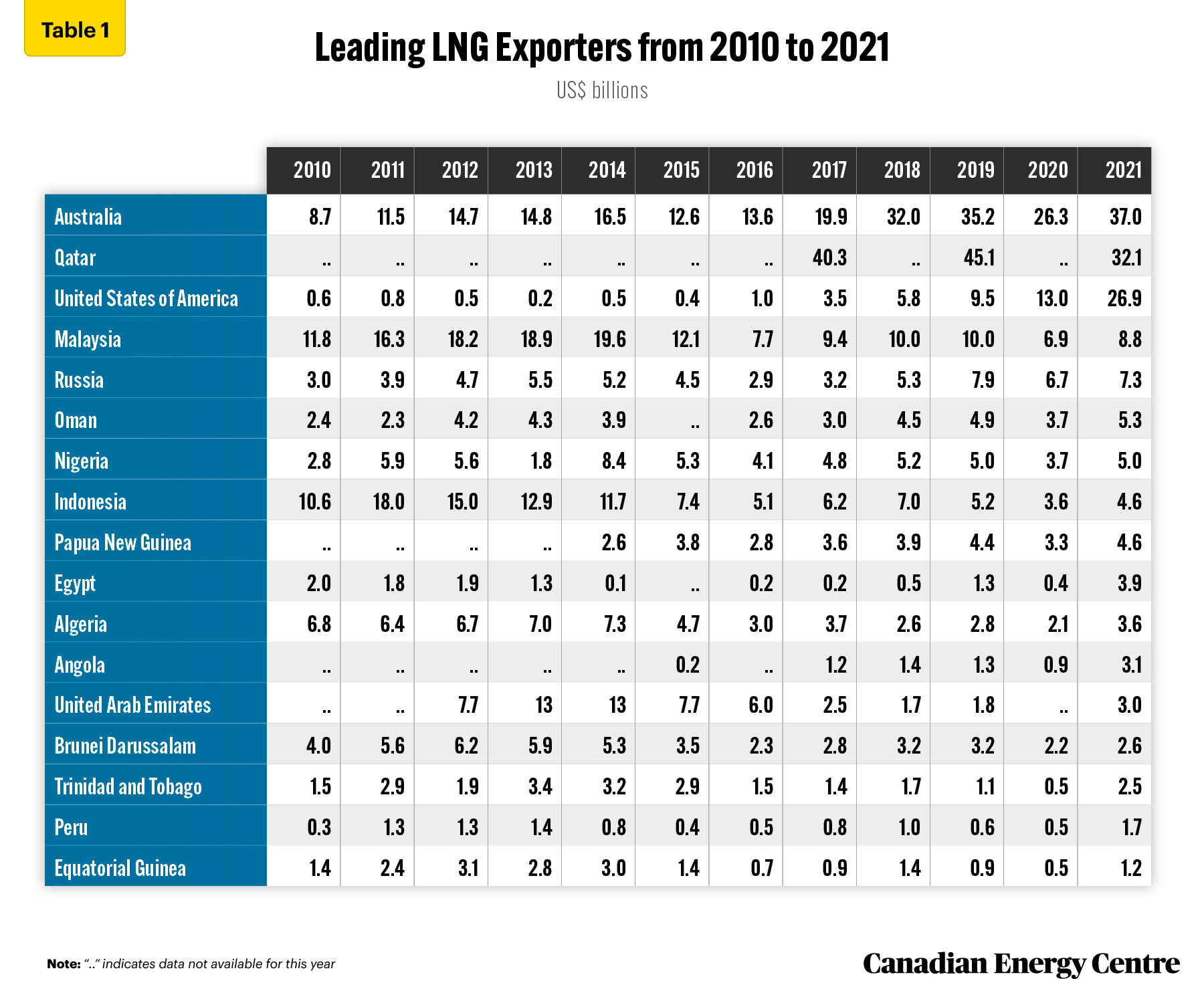
Source: International Trade Centre (undated).
Growth in LNG liquefaction capacity
As of 2021, 21 countries were LNG exporters (International Gas Union, 2021). To be competitive in the LNG export market requires a significant investment of capital and time. That is partly because it takes more than ten years on average to complete an LNG terminal from the start of the planning stage to the day that exports begin leaving the terminal (PWC, 2014).
Countries that export natural gas by sea require a liquefaction terminal, which turns natural gas into a liquid to make it suitable to transport. Presently, there are more than 115 liquefaction plants in the world. At 21 facilities, Australia has the greatest number of operational LNG export terminals. The United States follows with 17, while Qatar has 14 LNG export terminals (Enerdata, 2022).
Total liquefaction capacity worldwide was 452.9 million tonnes per annum (MTPA)³ in 2020. Australia has the most liquefaction capacity at 87.6 MTPA, followed by Qatar (77.4 MTPA) and the U.S. (71.6 MTPA) (International Gas Union, 2021). The top three countries, the U.S., Qatar, and Australia account for more than half of the global liquefaction capacity (see Figure 7).
3. The approximate conversion factor for LNG to natural gas is: 1 MTPA = 1.36 bcm (BP, undated).
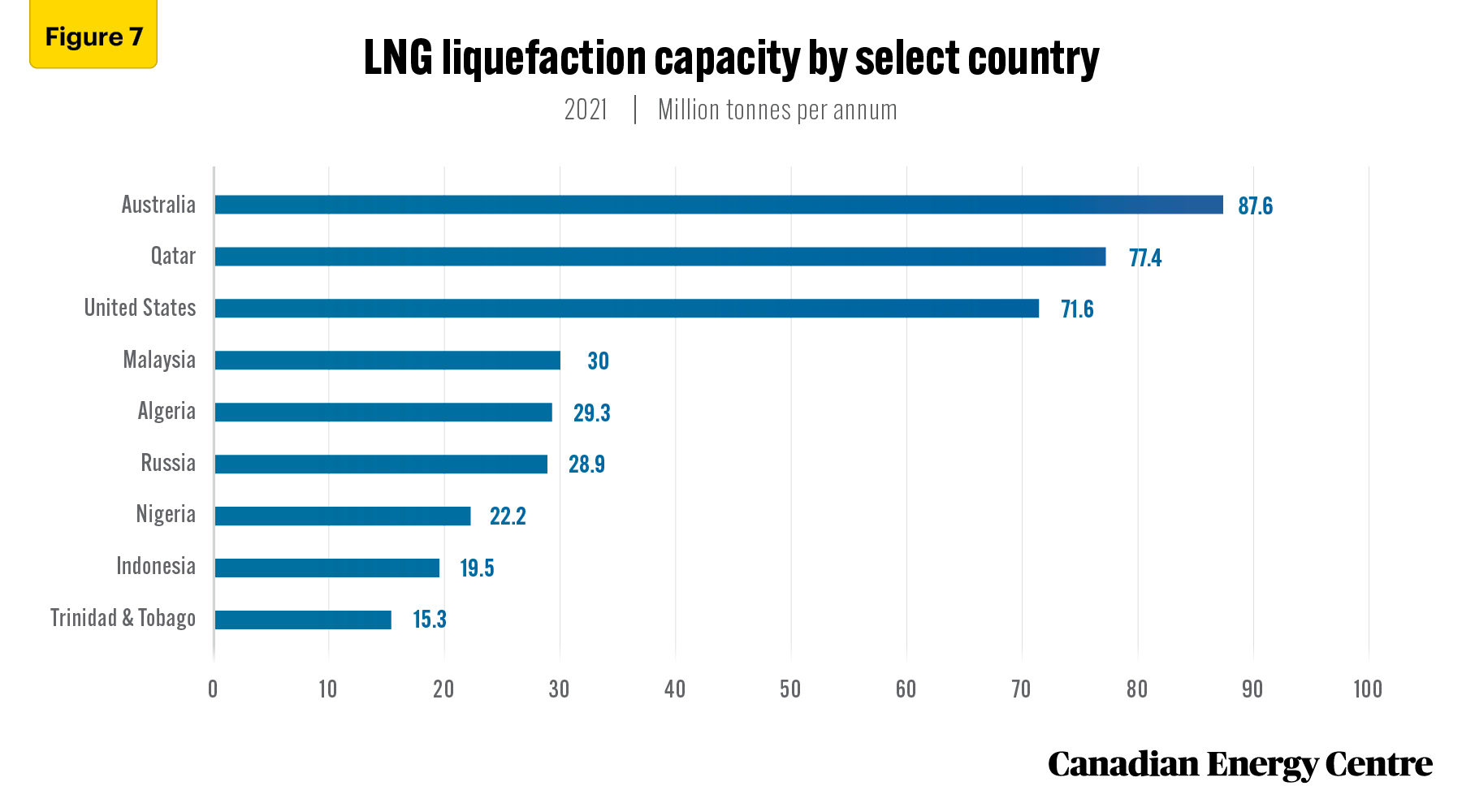
Source: International Gas Union (2021).
More than 20 unsanctioned projects with a liquefaction capacity of over 186 MTPA are in the planning stage and reported some developmental progress around the globe (Rystad, 2022b). Currently, at this time, Canada’s share as is just three per cent (see Figure 8), but, as discussed below, there is much more potential from Canada in the longer-term.
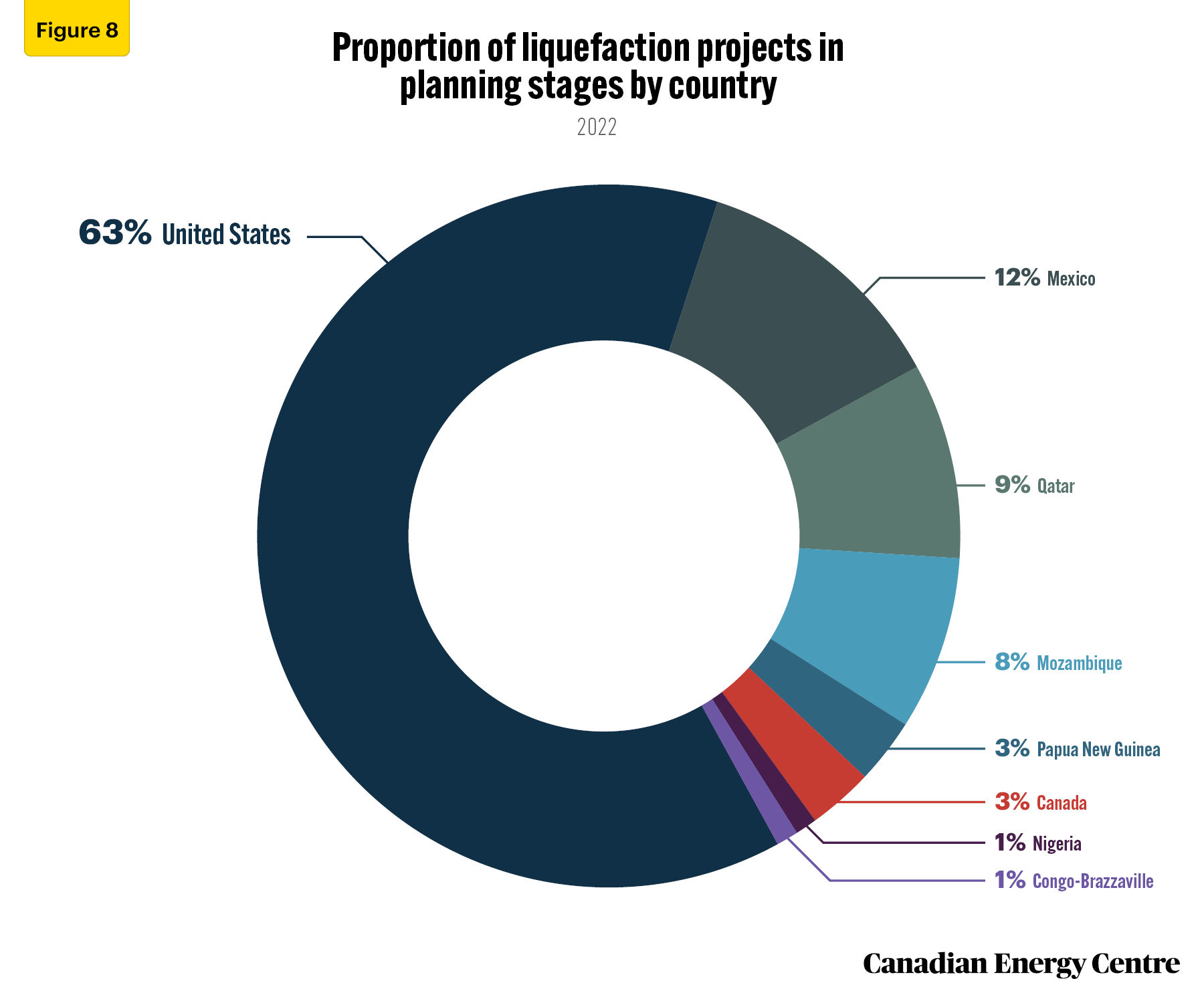
Source: Rystad Energy Gas Market Cube.
Opportunities and challenges for Canada’s LNG industry
The prospects for growth in the Canadian LNG industry have brightened over the last few months. High natural gas prices and ongoing energy supply disruptions in Europe due to the Russia-Ukraine conflict have created a unique opportunity and challenge for the Canadian energy sector. At the same time, natural gas and LNG are seen as fuels that can be relied upon as the world transitions to a low-carbon economy, especially in Asia, which is currently highly reliant on coal for its energy needs.
Historically, major economies in Asia and Europe have relied on imported natural gas to meet a significant portion of their natural gas needs. The share of LNG in the global natural gas trade increased from nearly 20 per cent in 1995 to over 38 per cent in 2020. In Asia, the share of LNG in natural gas imports is 77.6 per cent, while in Europe, the share of natural gas that comes through LNG jumped from 6.2 per cent to nearly 20 per cent in 2020 (see Figure 9) (Derived from Enerdata, 2022).
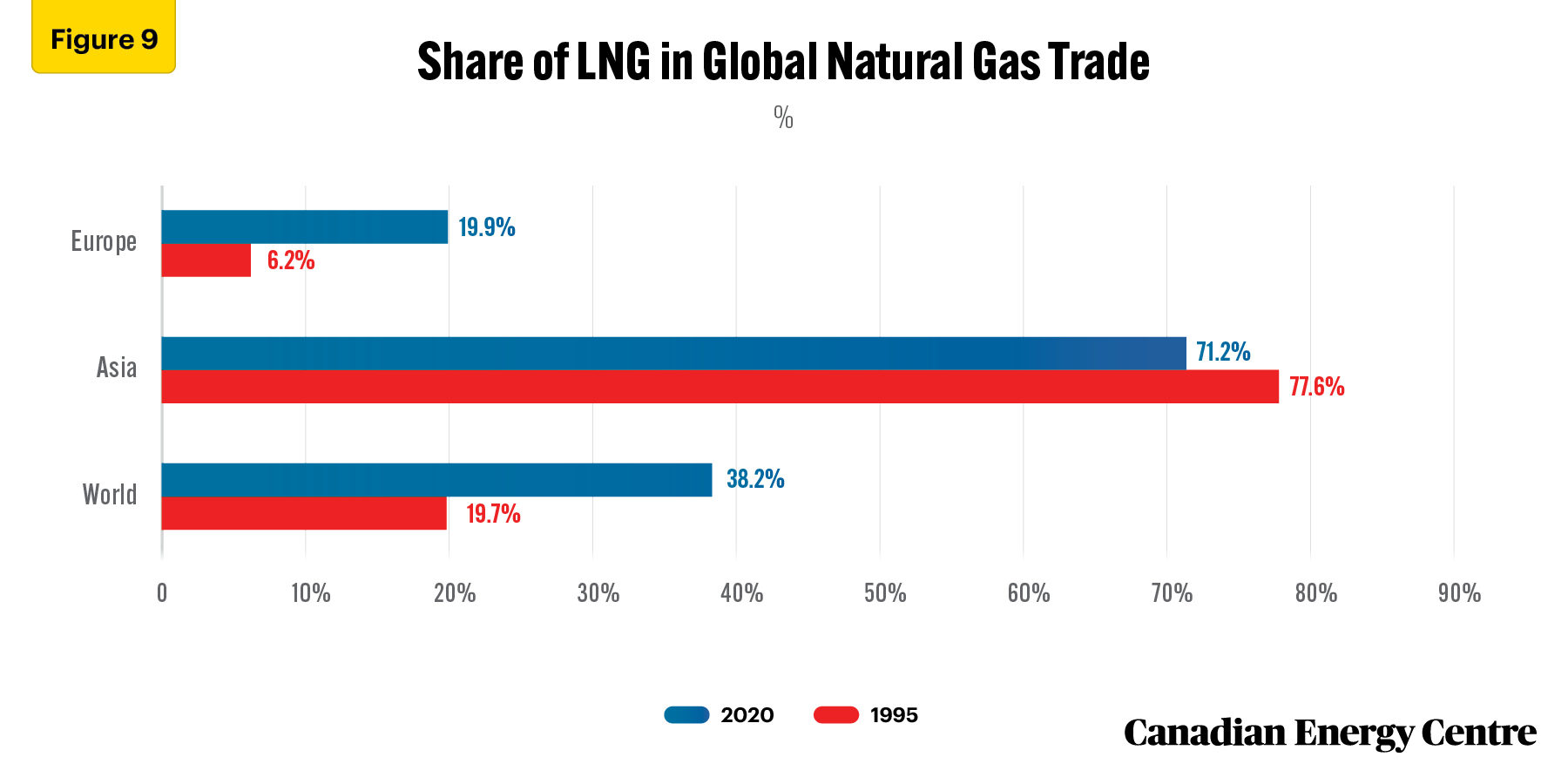
Source: Authors’ calculation from Enerdata (2022).
A recent Shell study, Shell LNG Outlook 2022, projects LNG demand will double by 2040 and reach over 700 million tonnes (MT) from its current 2021 level of 380 MT (Shell, 2022).
Canada is the world’s fifth-largest producer of natural gas, and the largest exporter not exporting to Asia or Europe. For Canada to directly export natural gas to Asia and Europe, it will not only need to increase the volume of natural gas it produces, but will need facilities on its west and east coast that can liquefy the natural gas in preparation for export.
Canada’s natural gas market is integrated with the U.S. market. In 2021, Canada exported nearly 79 billion cubic meters (bcm) of natural gas by pipeline to the U.S. Canadian natural gas exports are projected to increase to 110 bcm by 2035 (see Figure 10) (Rystad Energy, 2022a).
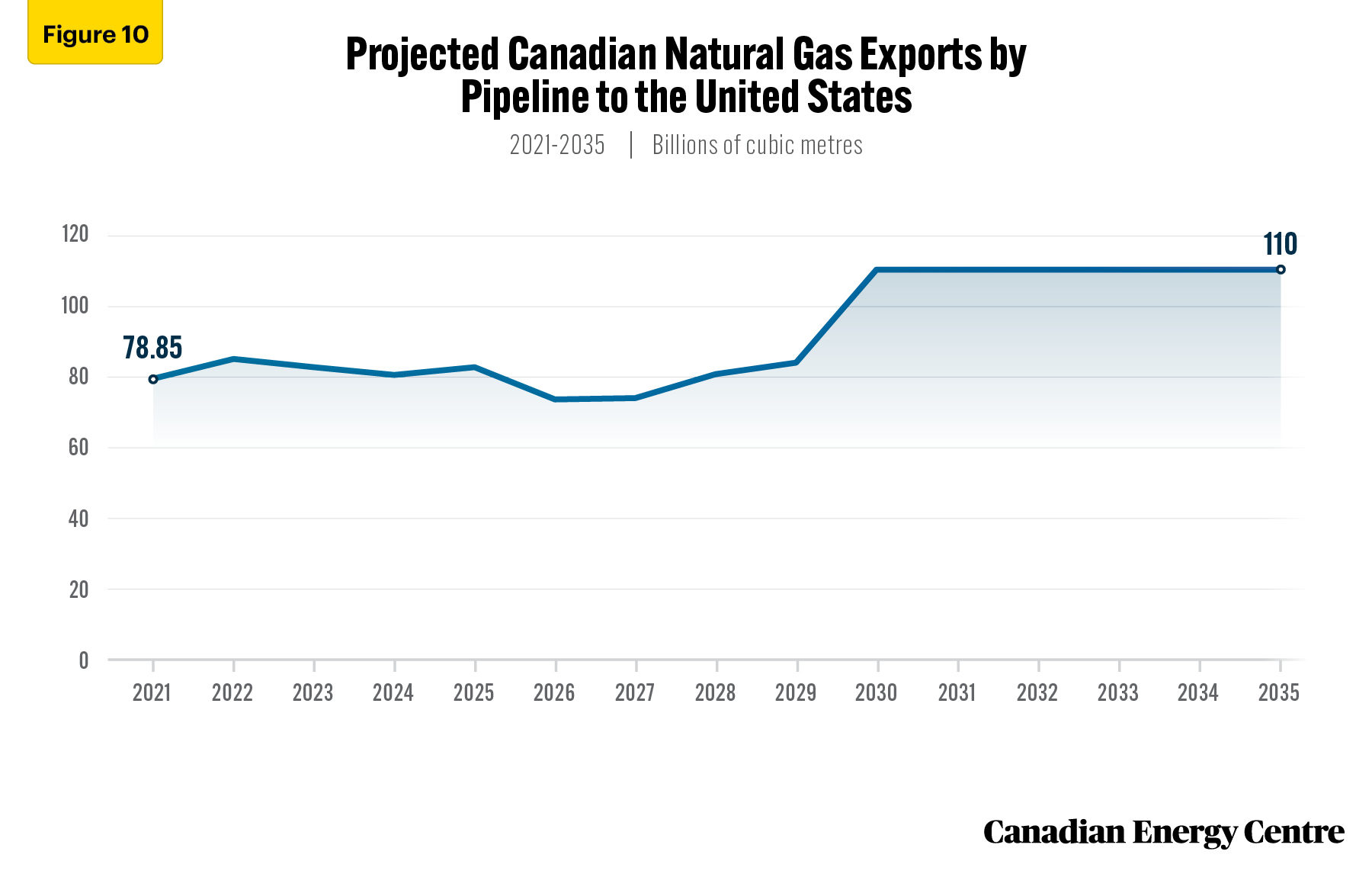
Source: Rystad Energy Gas Market Cube.
As noted earlier, west coast Canadian LNG projects under construction and proposed have several advantages over those in other countries. One clear advantage is the shorter distance between British Columbia’s coast and many Asian markets than from facilities in the USGC. For example, the distance between the US Gulf Coast and the Japanese ports of Himeji or Sodegaura is more than 9,000 nautical miles, compared to less than 4,200 nautical miles between those Japanese ports and the coast of British Columbia (Steuer, 2019).
One of the main challenges for LNG projects in Canada is construction cost. Factors pushing prices up are ongoing inflation and the cost of finance (the rise in interest rates), which both affect construction costs. Increasing construction costs mean that projects would need to be able to secure higher prices to be confident of a minimum rate of return on investment before they bring their production on line.
According to Rystad Energy, assuming all planned LNG facilities go forward, Canadian LNG production would begin in 2025 at 3.3 bcm per year, rise to 55.1 bcm per year by 2039, and then fall slightly to 52.6 bcm by 2050 (see Figure 11) (Rystad Energy, 2022). Most of this LNG would be exported to the Asia-Pacific through BC’s west coast. Still, there is a possibility that some of Canada’s natural gas production could be directed to Europe if suitable liquefaction infrastructure were built on Canada’s east coast.
Various studies have estimated the potential contribution that LNG exports could make to the Canadian economy. One of those reports, a 2016 Conference Board study, estimated that an LNG export industry equivalent to 30 MTPA in British Columbia could add roughly $CA7.4 billion annually to Canada’s economy over the next 30 years and raise national employment by 65,000 jobs annually (Conference Board of Canada, 2016).
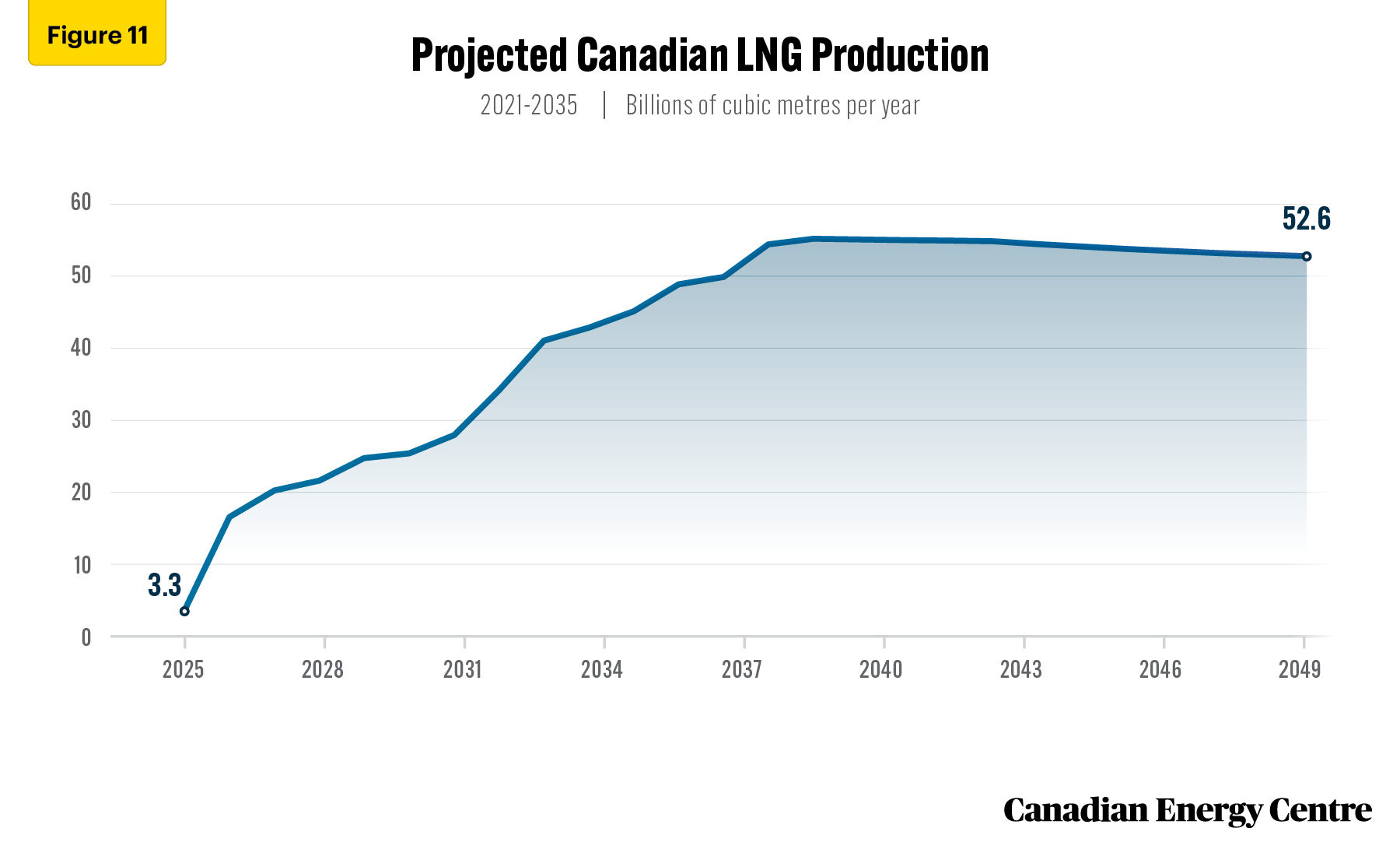
Source: Rystad Energy Gas Market Cube.
Conclusion
The international LNG export trade was valued at US$157 billion annually in 2021. Canada, however, is not currently involved in the global LNG export trade and does not share in any of the LNG trade market.
Energy security concerns due to the war in Ukraine, high energy prices, and Asia’s desire to shift away from coal, all provide Canada with an exceptional opportunity. Canadian LNG can play a significant role in meeting the world’s energy needs if this country can become a reliable supplier.
Canada’s decision-makers should view LNG positively and remove the regulatory bottlenecks that have hampered its development in recent years.
CEC Research Briefs
Canadian Energy Centre (CEC) Research Briefs are contextual explanations of data as they relate to Canadian energy. They are statistical analyses released periodically to provide context on energy issues for investors, policymakers, and the public. The source of profiled data depends on the specific issue. All percentages in this report are calculated from the original data, which can run to multiple decimal points. They are not calculated using the rounded figures that may appear in charts and in the text, which are more reader friendly. Thus, calculations made from the rounded figures (and not the more precise source data) will differ from the more statistically precise percentages we arrive at using the original data sources.
About the authors
This CEC Research Brief was compiled by Ven Venkatachalam, Chief Research Analyst, and Lennie Kaplan, Executive Director of Research, Canadian Energy Centre.
Acknowledgments and Notes
The authors and the Canadian Energy Centre would like to thank and acknowledge the assistance of Dennis Sundgaard and an anonymous reviewer for the review of this paper.
References (Links live as of June 9, 2022)
B.P. (undated). Approximate Conversion Factors. Statistical Review of World Energy. <https://on.bp.com/3z2oa5a>. Conference Board of Canada (2016). B.C.Future Liquefied Natural Gas Industry Could Fuel Economic and Job Growth in the Provinces and Canada for Decades. News Release. <https://bit.ly/3MzlLCg>. Disavino, Scott (2021, December 21). U.S. to be world’s biggest LNG exporter in 2022. Reuters. <https://reut.rs/3t38R8D>. Bishop, Grant, and Grant Sprague (2019). A Crisis of Our Own Making: Prospects for Major Natural Resource Projects in Canada. Commentary 534. CD Howe Institute. <https://bit.ly/3q6jioM>. British Petroleum Company [BP] (2021). Statistical Review of World Energy: 2021. <https://on.bp.com/3NX4ZPa>. Enerdata (2022). World LNG Database. <https://bit.ly/3N6qgFu>. International Energy Agency [IEA] (2020a). Gas 2020. IEA. <https://bit.ly/35oEe1O>. International Energy Agency [IEA] (2020b). Data and Statistics. Database. IEA. <https://bit.ly/34nYWOF>. International Energy Agency [IEA] (2022). Gas Market Report, Q2-2022. IEA. <https://bit.ly/3wX4K09>. International Gas Union [IGU] (2020). 2020 World LNG Report. <https://bit.ly/3x9RdBf>. International Gas Union [IGU] (2021). World LNG Report 2021.<https://bit.ly/3xAl2MV>. International Trade Centre (undated). Trade Map. <https://bit.ly/38gM0gg>. McConaghy, Dennis, and Ron Wallace (2019). Salvaging Canadian LNG Potential. Canadian Global Affairs Institute. <https://bit.ly/2Va6sY4>. Milke, Mark, and Lennie Kaplan (2020). Missing Out: Natural Gas and Canada’s Exports: A Worldwide Snapshot, 2000 to 2017. Research Brief Two. Canadian Energy Center. <https://bit.ly/39jvexi>. Moore, Michal, David Hackett, Leigh Noda, Jennifer Winter, Roman Karski, and Mark Pilcher (2014). Risky Business: The Issue of Timing, Entry, and Performance in the Asia-Pacific LNG Market. SPP Research Paper 7, 18. University of Calgary, School of Public Policy. <https://bit.ly/3mbUhpP>. Morgan, Geoffrey (2020, March 5). Warren Buffett’s Exit from $9-billion Quebec LNG Project after Rail Blockades ‘A Signal’ to Investors. Financial Post. <https://bit.ly/2IzDj5Y>. Natural Resources Canada (2020). Canadian LNG Projects. Government of Canada. <https://bit.ly/369EaU9>. PricewaterhouseCoopers [PWC] (2014). Canadian LNG Projects: The Progression of an LNG Project. <https://pwc.to/2I7MqL0>. Rystad Energy. (2021). Canada seeks to re-enter global LNG race with focus on First Nation involvement. <https://bit.ly/3krikBS>. Rystad Energy (2022a). Gas Market Cube. <https://bit.ly/3NbRXwg>. Rystad Energy. (2022b). The new center of the LNG universe. <https://bit.ly/3krikBS>. Shell (2022). Shell LNG Outlook 2022. <https://go.shell.com/3NUwB6y>. Steuer, Claudio (2019). Outlook for Competitive LNG Supply. OIES Paper NG 142. Oxford Institute of Energy Studies. <https://bit.ly/3gGVl38>.
Creative Commons Copyright
Research and data from the Canadian Energy Centre (CEC) is available for public usage under creative commons copyright terms with attribution to the CEC. Attribution and specific restrictions on usage including non-commercial use only and no changes to material should follow guidelines enunciated by Creative Commons here: Attribution-NonCommercial-NoDerivs CC BY-NC-ND.
